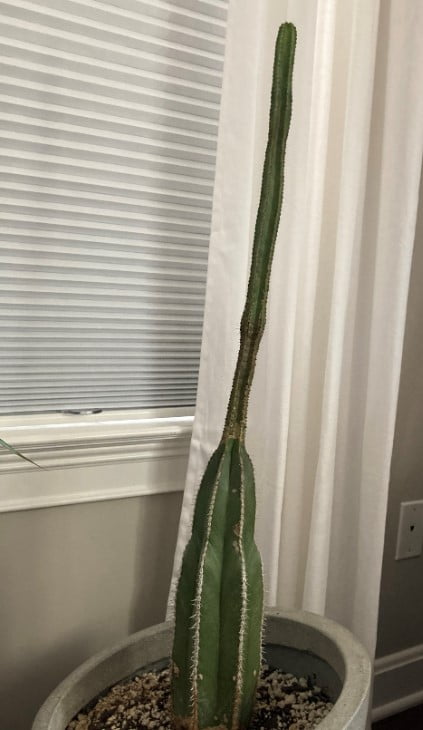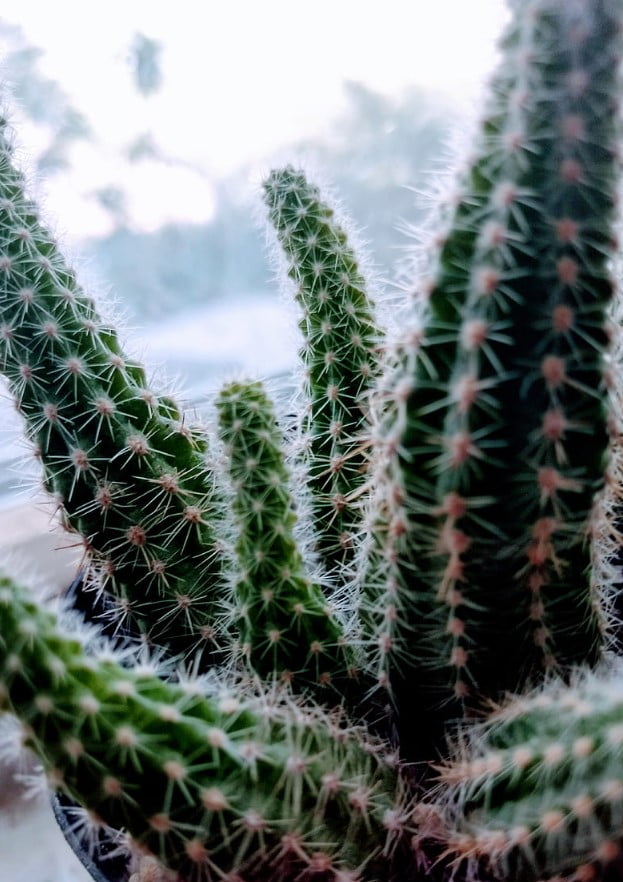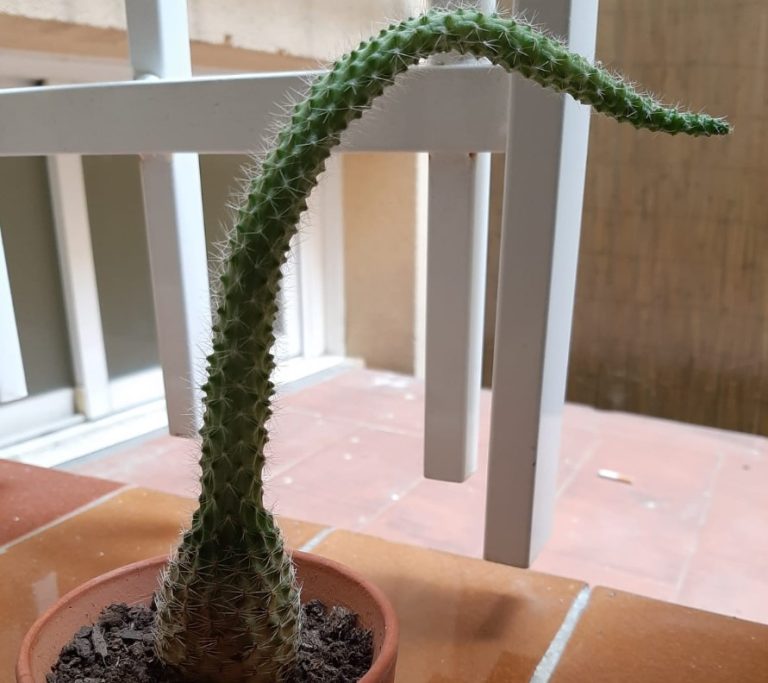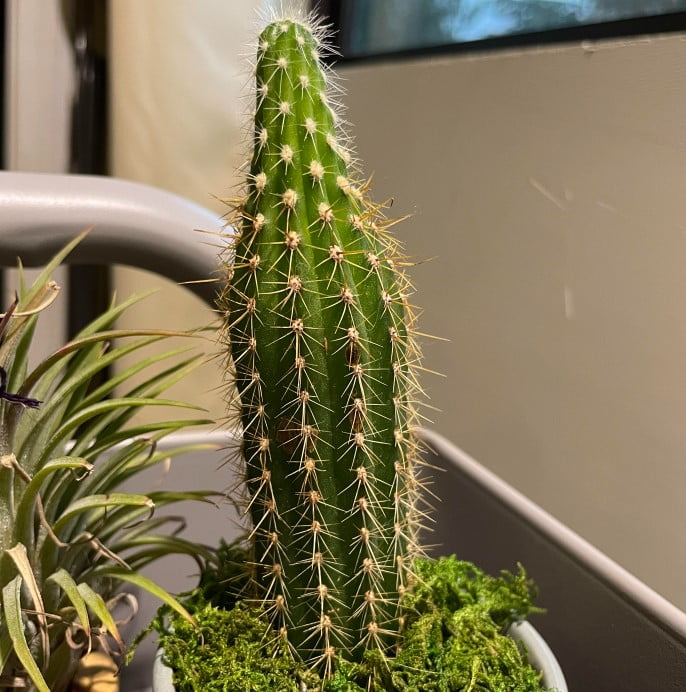Cacti are the stoic guardians of our windowsills and gardens. They ask for little but give much in return—beauty, resilience, and a touch of the exotic. However, even these hardy plants can face challenges, and one such challenge is etiolation. What cause Etiolated Cactus? The primary cause of etiolation in cacti is insufficient light. Other factors can include incorrect lighting conditions, seasonal changes affecting light exposure, and unsuitable soil conditions.
Etiolation is a term that might sound foreign, but its effects are all too visible: a pale, stretched-out cactus yearning for better days.
This article aims to be your comprehensive guide to understanding the etiolated cactus problem and how to fix it. We’ll delve into the signs, causes, and solutions, ensuring you’re well-equipped to restore your cactus to its former glory.
Key Takeaways
| Number | Key Point | Description |
|---|---|---|
| 1 | Understand Etiolation | Know what etiolation is and how it affects cacti to effectively treat it. |
| 2 | Spot the Signs | Early detection of symptoms like pale color and elongated growth is crucial for reversal. |
| 3 | Identify Causes | Lack of sunlight and poor soil are common causes; knowing them helps in prevention. |
| 4 | Immediate Action | Re-evaluate light conditions, repot in suitable soil, and consider pruning. |
| 5 | Long-term Solutions | Use light meters, adjust fertilization, and monitor regularly to prevent recurrence. |
| 6 | Prevention | Choose the right location and understand your cactus’s specific light needs for long-term health. |
| 7 | Understanding is Half the Battle | Knowing what etiolation is and how to spot it is crucial for effective treatment. |
| 8 | Immediate Action is Vital | The sooner you address the issue, the better the chances of full recovery for your cactus. |
| 9 | Prevention is Best | Regular monitoring and proper care can prevent etiolation from occurring in the first place. |
What is Etiolation?
Etiolation is a biological phenomenon that occurs when a plant receives insufficient light. It’s nature’s way of telling you that your plant is struggling to perform photosynthesis, the process by which plants convert light into energy. In a desperate bid to find more light, the plant begins to stretch and grow taller, often sacrificing its color and structural integrity in the process.
For cacti, this is particularly problematic. These are plants adapted to harsh, sun-drenched environments. They’re built to store water and make the most of abundant sunlight. When they don’t get the light they need, they can’t function as they’re supposed to. The result is a cactus that looks more like a pale, elongated version of its former self rather than the robust, vibrant plant it should be.
Did You Know?
Etiolation is not a disease but a symptom of poor growing conditions. It’s reversible if caught early, but prevention is always better than cure.

Signs of an Etiolated Cactus
Recognizing the signs of an etiolated cactus is the first step toward remedying the issue. Here are some of the most common symptoms:
- Pale Color: A healthy cactus should be green or, depending on the species, have a vibrant hue. An etiolated cactus will lose its color, becoming pale or even white.
- Stretched or Elongated Growth: Instead of growing in its typical compact form, an etiolated cactus will stretch out, often in the direction of the light source it’s trying to reach. This results in a lanky, disproportionate appearance.
- Weak or Thin Stems: The stems of an etiolated cactus will be weaker and thinner than those of a healthy plant. This is because the plant is using its limited resources to grow taller rather than stronger.
- Lack of Spines or Reduced Spination: Some cacti will produce fewer spines or even lose them altogether when etiolated. This is another sign that the plant is not receiving the light it needs to grow properly.
Table: Common Signs of Etiolation in Cacti
| Symptom | Description |
|---|---|
| Pale Color | Loss of vibrant hue, becoming pale or white |
| Stretched Growth | Elongated, lanky appearance |
| Weak or Thin Stems | Stems become weaker and thinner |
| Lack of Spines | Reduced spination or complete loss of spines |
Pro Tip:
Early detection is crucial for reversing etiolation. Regularly inspect your cactus for these signs, especially during seasons when sunlight is less abundant.

Causes of Etiolated Cactus
Understanding the root causes of etiolation can help you not only fix the problem but also prevent it from happening again. Here are some of the primary factors:
- Lack of Sunlight: The most common cause of etiolation is insufficient light. Cacti are sun-loving plants that require plenty of natural light to thrive.
- Incorrect Lighting Conditions: Even if a cactus receives light, it may not be the right kind. Fluorescent lights, for example, don’t provide the full spectrum of light that a cactus needs.
- Seasonal Changes: During winter, the amount of available sunlight decreases, which can lead to etiolation if not managed properly.
- Unsuitable Soil Conditions: While less common, poor soil can also contribute to etiolation. Cacti need well-draining soil to prevent root rot, which can further stress the plant and make it more susceptible to etiolation.
Table: Causes of Etiolation in Cacti
| Cause | Description |
|---|---|
| Lack of Sunlight | Insufficient natural light leading to poor growth |
| Incorrect Lighting | Wrong type of artificial light |
| Seasonal Changes | Reduced sunlight during winter months |
| Poor Soil Conditions | Soil that doesn’t drain well can contribute to stress and etiolation |
Did You Know?
Cacti are native to regions with high light levels, including deserts and mountain ranges. They are genetically programmed to seek light, which is why they react so dramatically to insufficient lighting conditions.

How to Fix an Etiolated Cactus
So, you’ve identified that your cactus is etiolated. What now? The good news is that etiolation is often reversible, especially if caught early. Here’s how to go about fixing the issue:
Immediate Steps
- Re-evaluate Light Conditions: The first step is to move your cactus to a location where it will receive adequate natural light. South-facing windows are often a good choice.
- Repotting in Suitable Soil: If the soil is also a contributing factor, consider repotting your cactus in a well-draining cactus mix.
- Pruning and Care: In some cases, you may need to prune severely etiolated parts to encourage new, healthy growth. Always use sterilized tools to prevent infection.
Long-term Solutions
- Light Meters and Artificial Lighting: If natural light is hard to come by, consider investing in full-spectrum artificial lights. Light meters can help you monitor light levels.
- Fertilization Adjustments: A balanced, diluted fertilizer can help your cactus recover more quickly. However, avoid over-fertilization as this can lead to other problems.
- Monitoring and Regular Check-ups: Once you’ve addressed the immediate issues, regular monitoring is essential to ensure that the problem doesn’t recur.
Table: Steps to Fix an Etiolated Cactus
| Step | Action |
|---|---|
| Re-evaluate Light | Move to a location with adequate natural light |
| Repotting | Use well-draining soil |
| Pruning | Remove severely etiolated parts |
| Artificial Lighting | Use full-spectrum lights if natural light is insufficient |
| Fertilization | Use balanced, diluted fertilizer |
| Monitoring | Regular check-ups to prevent recurrence |
Pro Tip:
Recovery takes time. Don’t expect immediate results, and avoid the temptation to overcompensate with too much light or fertilizer, as this can lead to other issues.
Preventing Future Etiolation
Prevention is always better than cure, especially when it comes to etiolation in cacti. Here are some proactive steps you can take to ensure your cactus stays healthy and vibrant:
- Choosing the Right Location: Make sure to place your cactus in a location where it will receive plenty of natural light. South-facing windows are often ideal for this.
- Understanding Light Needs: Different cactus species have different light requirements. Research your specific species to ensure you’re meeting its needs.
- Regular Monitoring: Make it a habit to regularly inspect your cactus for signs of etiolation, especially during seasons when natural light is less abundant.
- Seasonal Adjustments: Be prepared to move your cactus or adjust its lighting conditions based on the season. Some cacti may require additional light during the winter months.
- Soil Quality: Always use well-draining soil and consider adding sand or perlite to improve drainage.
Table: Preventive Measures Against Etiolation
| Measure | Action |
|---|---|
| Right Location | Choose a spot with adequate natural light |
| Species Research | Understand the specific light needs of your cactus |
| Regular Checks | Inspect your cactus regularly for signs of etiolation |
| Seasonal Adjustments | Be prepared to change lighting conditions based on the season |
| Soil Quality | Use well-draining soil and consider adding sand or perlite |
Did You Know?
Some cacti species are more prone to etiolation than others. Species that are native to lower light conditions are generally more forgiving of less-than-ideal lighting situations.
FAQs Etiolated Cactus
Questions often arise when dealing with an issue like etiolation. Here are some frequently asked questions and their answers:
- Is Etiolation Reversible?
Yes, etiolation is often reversible, especially if caught early. However, severely etiolated parts may need to be pruned. - Can an Etiolated Cactus Recover Fully?
With proper care and adjustments to its environment, an etiolated cactus can often recover fully. However, it may take time for the plant to regain its original form. - How Long Does It Take to Fix an Etiolated Cactus?
The time it takes for a cactus to recover from etiolation varies depending on the severity of the condition and the steps taken to correct it. Patience is key. - Is Etiolation Harmful to the Cactus?
While etiolation is not immediately life-threatening, it does indicate that the plant is not in optimal health. Left untreated, it can lead to further complications.
Table: Frequently Asked Questions About Etiolation
| Question | Answer |
|---|---|
| Is Etiolation Reversible? | Often reversible if caught early |
| Can an Etiolated Cactus Recover Fully? | Possible with proper care and environmental adjustments |
| How Long Does It Take to Fix? | Varies; patience is key |
| Is Etiolation Harmful? | Not immediately life-threatening but indicates poor health |
Pro Tip:
If you have a question that hasn’t been answered in this section, don’t hesitate to consult with a local nursery or cactus expert. They can provide tailored advice based on your specific situation.
Conclusion Etiolated Cactus
Etiolation in cacti is a common issue that many plant owners face, but it’s far from insurmountable. With the right knowledge and care, you can not only fix an etiolated cactus but also prevent future occurrences. The key is to understand the specific needs of your cactus species, particularly when it comes to light and soil conditions.
Did You Know?
Cacti are among the most resilient plants on Earth, capable of surviving in some of the harshest conditions. With a little attention and care, they can thrive in your home or garden for years to come.
Thank you for reading this comprehensive guide on the etiolated cactus problem and how to fix it. Armed with this knowledge, you’re well-equipped to ensure that your cactus lives a long, healthy life.


